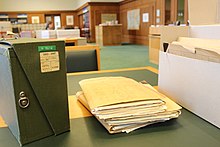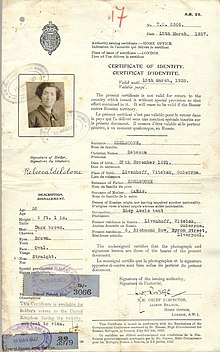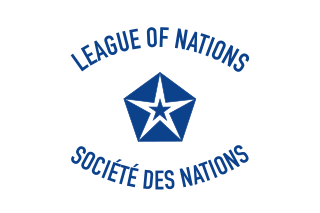
The League of Nations was the first worldwide intergovernmental organisation whose principal mission was to maintain world peace. It was founded on 10 January 1920 by the Paris Peace Conference that ended the First World War. The main organization ceased operations on 18 April 1946 when many of its components were relocated into the new United Nations. As the template for modern global governance, the League profoundly shaped the modern world.

The United Nations Economic Commission for Europe is one of the five regional commissions under the jurisdiction of the United Nations Economic and Social Council. It was established in order to promote economic cooperation and integration among its member states.

The United Nations Secretariat is one of the six principal organs of the United Nations (UN), The secretariat is the UN's executive arm. The secretariat has an important role in setting the agenda for the deliberative and decision-making bodies of the UN, and the implementation of the decision of these bodies. The secretary-general, who is appointed by the General Assembly, is the head of the secretariat.

The National Digital Library Program (NDLP) is a project by the United States Library of Congress to assemble a digital library of reproductions of primary source materials to support the study of the history and culture of the United States. The NDLP brought online 24 million books and documents from the Library of Congress and other research institutions.

Digitization is the process of converting information into a digital format. The result is the representation of an object, image, sound, document, or signal obtained by generating a series of numbers that describe a discrete set of points or samples. The result is called digital representation or, more specifically, a digital image, for the object, and digital form, for the signal. In modern practice, the digitized data is in the form of binary numbers, which facilitates processing by digital computers and other operations, but digitizing simply means "the conversion of analog source material into a numerical format"; the decimal or any other number system can be used instead.
Between 1920 and 1946, a total of 63 countries became member states of the League of Nations.

Library and Archives Canada is the federal institution tasked with acquiring, preserving, and providing accessibility to the documentary heritage of Canada. The national archive and library is the 16th largest library in the world. The LAC reports to the Parliament of Canada through the Minister of Canadian Heritage.
In library and archival science, digital preservation is a formal process to ensure that digital information of continuing value remains accessible and usable in the long term. It involves planning, resource allocation, and application of preservation methods and technologies, and combines policies, strategies and actions to ensure access to reformatted and "born-digital" content, regardless of the challenges of media failure and technological change. The goal of digital preservation is the accurate rendering of authenticated content over time.
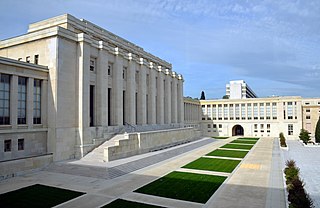
The United Nations Office at Geneva in Geneva, Switzerland, is one of the four major offices of the United Nations where numerous different UN agencies have a joint presence. The main UNOG administrative offices are located inside the Palais des Nations complex, which was originally constructed for the League of Nations between 1929 and 1938.

The Dag Hammarskjöld Library is a library on the grounds of the headquarters of the United Nations, located in the Turtle Bay/East Midtown neighborhood of Manhattan in New York City. It is connected to the Secretariat and Conference buildings through ground level and underground corridors. It is named after Dag Hammarskjöld, the second Secretary-General of the United Nations. The library was founded in 1946, and the current library building was completed in 1961.
The Metadata Encoding and Transmission Standard (METS) is a metadata standard for encoding descriptive, administrative, and structural metadata regarding objects within a digital library, expressed using the XML schema language of the World Wide Web Consortium (W3C). The standard is maintained as part of the MARC standards of the Library of Congress, and is being developed as an initiative of the Digital Library Federation (DLF).

The Biodiversity Heritage Library (BHL) is the world’s largest open access digital library for biodiversity literature and archives. BHL operates as a worldwide consortium of natural history, botanical, research, and national libraries working together to address this challenge by digitizing the natural history literature held in their collections and making it freely available for open access as part of a global "biodiversity community". The BHL consortium works with the international taxonomic community, publishers, bioinformaticians, and information technology professionals to develop tools and services to facilitate greater access, interoperability, and reuse of content and data. BHL provides a range of services, data exports, and APIs to allow users to download content, harvest source data files, and reuse materials for research purposes. Through taxonomic intelligence tools developed by Global Names Architecture, BHL indexes the taxonomic names throughout the collection, allowing researchers to locate publications about specific taxa. In partnership with the Internet Archive and through local digitization efforts, BHL's portal provides free access to hundreds of thousands of volumes, comprising over 59 million pages, from the 15th-21st centuries.
The Hamilton Library at the University of Hawaiʻi at Mānoa is the largest research library in the state of Hawaii. The Library serves as a key resource for the flagship Manoa campus as well as the other University of Hawaiʻi system campuses.
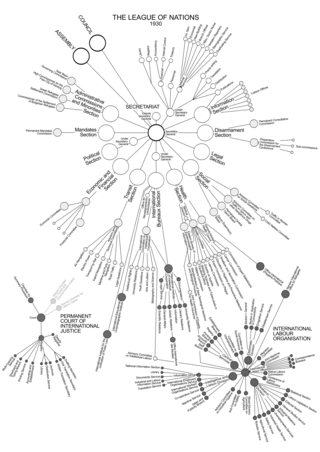
The League of Nations was established with three main constitutional organs: the Assembly; the Council; the Permanent Secretariat. The two essential wings of the League were the Permanent Court of International Justice and the International Labour Organization.
The United Nations Dispute Tribunal (UNDT) is the court of first instance in the internal justice system of the United Nations. It became operational on 1 July 2009. The UNDT "hears and decides cases" filed by current and former staff members "appealing administrative decisions alleged to be in non-compliance with their terms of appointment or contract of employment". The staff members as well as the Administration have a "right to appeal the judgments of the UNDT to the United Nations Appeals Tribunal (UNAT)". In order to ensure the independence of this organ, it is composed not of officials of the Organization, but by judges appointed by the Member States of the United Nations through the General Assembly, from which UNDT derives its mandate.

Michael Møller is president of the Diplomatic Forum of the Geneva Science and Diplomacy Anticipator Foundation, principal advisor at Macro Advisory Partners and member of the boards of several foundations, including the Kofi Annan Foundation. He is Honorary President of the Association of Former International Civil Sevants for Development (Greycells). He is a Danish former Under-Secretary-General of the United Nations and the 12th director-general of the United Nations Office at Geneva (UNOG). He was also the secretary-general of the Conference on Disarmament and the United Nations Secretary-General's personal representative to the conference. He was appointed to these roles by Secretary-General Ban Ki-moon in November 2013 and was reappointed by Secretary-General António Guterres in February 2017 for another year. Møller has over 40 years of experience as an international civil servant in the United Nations System, serving in different roles in New York, Iran, Mexico, Haiti and Geneva. Prior to his tenure as director-general, he was the executive director of the Kofi Annan Foundation from 2008 to 2011.

The archives of the International Committee of the Red Cross (ICRC) are based in Geneva and were founded in 1863 at the time of the ICRC's inception. It has the dual function to manage both current records and historical archives. The general historical archives are openly accessible to the general public up to 1975.

The library of the International Committee of the Red Cross (ICRC) – in French: la bibliothèque du Comité international de la Croix-Rouge (CICR) – is a public library based at the headquarter of the international organization in Geneva, Switzerland. It was apparently founded around the time of the ICRC's inception in 1863.

The Library of the Economic Commission for Latin America and the Caribbean was established in 1948 as part of the creation of the Economic Commission for Latin America and the Caribbean; this coincided with the inauguration of the Economic Commission for Latin America by the United Nations, in support of its mandate in the region. The Library has four branches: the Hernán Santa Cruz Library in Santiago, the Centro de Recursos de Información y Distribución de Documentos in México D.F., the Raúl Prebisch Library in Brasilia and the Caribbean Knowledge Management Centre in Port of Spain. These four form the ECLAC Library.
